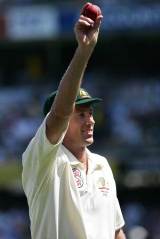How long is a career?
Tim de Lisle on the ever-lengthening careers of the modern cricketer
Tim de Lisle
12-Dec-2006
|
|

|
A cricketer's life is made up of a million little decisions. Should he
play the ball or leave it, attack or defend, hook or duck, run or shout
"waiting!", shape it in or away, go over or round the wicket, bust a
gut or bowl within himself, sign for Gray Nicolls or Gunn & Moore? Big
decisions, on the other hand, are few and far between, unless he
becomes a captain. He might get right to the top and never have a real
dilemma. But in the end he can expect to face a big one: to retire or
not to retire.
Damien Martyn has taken the bold option, going suddenly, not hanging
around for a last hurrah. His departure was as crisp as his offside strokeplay. A tough decision that the selectors had ducked, by bringing him back last season, ended up being taken by the player himself. The same may happen with Ashley Giles in the next few months.
It's understandable that selectors should be confused. International
cricket careers are like jeans: there's much less agreement than there
once was on how long they should be.
Mike Atherton, who retired at 33 after 13 years with England, said
recently that long careers were over. He cited two of his opening
partners - Graham Gooch (20 years an England player) and Alec Stewart
(14) - as having the sort of careers that wouldn't happen any more.
It's true that England careers are getting shorter in terms of time.
The typical major one now lasts 12 to 15 years for a batsman, about 10
for a bowler. Nasser Hussain spanned 15 years (with two long gaps, when
the England selectors regarded him as more of a troublemaker than a
potential saviour), Graham Thorpe 12. Darren Gough lasted nine years in
Tests, making a Martyn-like exit, but then going the other way and
sticking around for 12 years in one-dayers. Andy Caddick managed a
round decade, 1993 to 2003, and signed off with an Ashes seven-for.
He's not in Australia now, is he?
Around the world, careers are getting longer, when the injury gods
allow. Brian Lara made his Test debut 16 years ago this week. Sachin
Tendulkar is past 17 years, which means he has been a Test cricketer
for more than half his life. Anil Kumble is on 16, three more than
Bishen Bedi. Wasim Akram did 17, Waqar Younis 14. Courtney Walsh did
17, where most of the great West Indian bowlers settled for 12.
|
|
But the most dramatic change has come in Australia, where careers have
ballooned like children's waistlines. Glenn McGrath has done 13 years
and still wants more. Shane Warne is coming up to 15 years and probably
thinking in terms of another five. Old Chinese proverb say, if a man
appears in adverts for hair studios, he's not about to rush out of the
limelight.
When excellence and durability combine as they have with Australia's
35-year-olds, something else follows: the next generation misses out.
Only two current Australian players have a realistic chance of
following Warne and McGrath up into the rarefied air of 120 Test caps:
Ricky Ponting, who will get there next year and possibly go on to break
all records, and Michael Clarke. Other players, even when they are as
good as Mike Hussey, are going to get half a career, if that. It's
going to be fascinating to watch the big woolly moustaches on the
Aussie selection panel manage these transitions.
Troy Cooley, the only man currently on the way to his second successive
Ashes triumph, says fast bowlers can go on to 40 now, and McGrath is
hoping he is right. But nobody actually has. Even Walsh stopped at 38.
Richard Hadlee and Imran Khan just made it past their 39th birthdays,
although both at reduced pace, and in less treadmillish times, and
Imran converted himself from a bowler who batted into a batsman who
bowled.
A few years ago there was a theory that miles on the clock were what
counted, rather than sheer years. Waqar Younis may have been a case in
point (though doubts about his birth certificate rather muddied the
waters), and Marcus Trescothick could be now. But if cricketers were
like cars, some of today's veterans would already be in the
scrapyard. Tendulkar has batted for 48,000 minutes in international
cricket, which is 5,000 more than Steve Waugh, and probably more than
anybody ever, though Geoff Boycott would have done it in one innings if
he had only lived a little earlier and played in the Timeless Test.
Yet Tendulkar still has an appetite. And so do Muralitharan and Warne, who
have bowled 50,000 international deliveries each, while only one other
man (Kumble) has passed 41,000. How long is a career? We are in the
process of finding out.
Click here to comment on this article.
Tim de Lisle is a former editor of Wisden. His Ashes blog is at http://blogs.cricinfo.com/ashesbuzz and his website is www.timdelisle.com